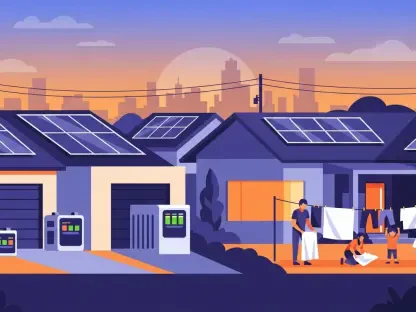As the world races to embrace renewable energy, solar panels have become a vital tool in the fight against climate change, powering homes and businesses with clean electricity. Yet, a hidden challenge lurks beneath this green revolution: recycling these panels at the end of their 25- to 30-year lifespan is proving to be an uphill battle. Designed to endure harsh weather, solar panels are built with tightly bonded layers of glass, silicon, and metals, which, while ensuring durability, make disassembly a labor-intensive and costly endeavor. This issue is compounded by economic disincentives, environmental risks, and a lack of infrastructure, creating a perfect storm of obstacles. With millions of panels nearing retirement, the urgency to address this growing waste problem cannot be overstated, as failing to do so risks undermining the very sustainability that solar energy promises.
Unpacking the Core Obstacles
Durability as a Double-Edged Sword
Solar panels are engineered for resilience, constructed with robust materials that can withstand decades of exposure to rain, wind, and extreme temperatures without faltering. This durability, however, turns into a significant barrier when the time comes to recycle them. The tightly bonded layers—often a mix of glass, silicon cells, and metal framing—are not easily separated, requiring specialized equipment and considerable manpower to break them down into recoverable components. The process becomes even more complex after years of environmental stress, as small cracks and corrosion weaken the structure but do not simplify disassembly. Without efficient methods to handle this robustness, recycling remains a daunting task that few facilities are equipped to manage, leaving a gap in the sustainable lifecycle of solar technology that must be addressed to prevent waste accumulation.
Another layer of complexity arises from the lack of recycling infrastructure tailored to handle such durable designs. In many regions, particularly in the U.S., facilities capable of safely and efficiently processing solar panels are scarce, often forcing stakeholders to resort to cheaper, less environmentally friendly disposal methods. The absence of widespread, accessible recycling centers means that even when the will to recycle exists, the practical means are often out of reach. This infrastructural shortfall not only perpetuates the cycle of waste but also highlights a critical oversight in the planning of renewable energy systems. Developing a network of specialized facilities, alongside innovations in disassembly techniques, could bridge this gap, but such solutions require significant investment and coordination across the industry to become a reality.
Economic Disincentives at Play
The financial landscape of solar panel recycling presents a stark reality that discourages sustainable practices among manufacturers and users alike. Recycling a single panel in the U.S. typically costs between $18 and $20, a figure that dwarfs the mere $1 to $5 expense of landfill disposal. When the value of recoverable materials like silver and copper hovers around just $10 to $12 per panel, the economic incentive to recycle is virtually nonexistent. This cost disparity drives a troubling trend, with an estimated 90% of decommissioned panels ending up in landfills rather than being repurposed, squandering valuable resources and adding to environmental burdens. Until the financial equation shifts, widespread adoption of recycling practices will remain elusive.
Beyond the immediate cost barrier, the inefficiencies of current recycling methods further exacerbate the economic challenge. Many existing processes are not only expensive but also fail to maximize material recovery, reducing the potential return on investment for recycling operations. The lack of advanced technologies to streamline disassembly and extraction means that the effort often outweighs the reward, discouraging companies from investing in sustainable end-of-life solutions. Addressing this issue demands innovation in recycling techniques that can lower costs while increasing the yield of high-value materials. Additionally, policy interventions, such as subsidies or mandates, could help balance the economic scales, encouraging stakeholders to prioritize recycling over disposal despite the upfront expenses.
Environmental and Systemic Roadblocks
Toxic Risks and Growing Waste Volumes
While solar energy is hailed for its environmental benefits, the disposal of older panels introduces significant ecological risks that cannot be ignored. Many panels, particularly those manufactured decades ago, contain toxic substances like lead and cadmium, which can seep into soil and water if improperly discarded in landfills. Compounding this danger is the difficulty in accurately identifying hazardous materials, as current testing methods often produce unreliable results. As a result, many companies opt to classify all panels as hazardous waste, driving up disposal costs and complicating recycling efforts. This environmental hazard underscores the critical need for better detection technologies and safer handling practices to prevent long-term damage.
The sheer scale of solar panel waste adds another dimension to the environmental challenge, with projections indicating that by 2030, retired panels worldwide could cover an area equivalent to 3,000 football fields. This looming crisis highlights the urgency of developing sustainable end-of-life management strategies to handle the growing volume of decommissioned technology. Without proactive measures, the environmental gains achieved through solar energy adoption risk being offset by the mounting waste problem. Governments and industry leaders must collaborate to establish clear guidelines and invest in solutions that can manage this escalating issue. The potential for widespread pollution serves as a stark reminder that clean energy must encompass the entire lifecycle of its components, not just their operational phase.
Design Flaws and Systemic Gaps
A fundamental barrier to effective recycling lies in the original design of solar panels, which prioritizes longevity over end-of-life considerations. Built to last for decades, these panels often use adhesives and bonded layers that resist separation, making the recycling process more energy-intensive and costly than the value of the materials recovered. This oversight in design means that breaking down a panel frequently requires resources that outweigh the benefits, perpetuating a cycle of waste. Rethinking how panels are constructed—perhaps by incorporating modular components or avoiding permanent adhesives—could pave the way for easier disassembly, but such changes demand a shift in industry standards and manufacturing practices.
Adding to the design challenge is the absence of standardized labeling on solar panels to indicate material composition or potential toxicity. Without clear information, recycling facilities struggle to handle panels safely and efficiently, often leading to mishandling or outright disposal in landfills. This systemic gap points to a broader need for industry-wide protocols that ensure transparency and facilitate proper end-of-life management. Efforts by organizations like the Solar Energy Industries Association to compile data on recycling options are a step forward, but much more is needed to create a cohesive framework. Addressing these systemic issues through policy mandates and collaborative innovation could transform the recycling landscape, ensuring that solar technology remains truly sustainable.
Looking Ahead to Sustainable Solutions
Innovations on the Horizon
Despite the formidable challenges, glimmers of hope emerge through innovative approaches aimed at revolutionizing solar panel recycling. Techniques like salt etching, which can recover over 99% of silver and 98% of silicon at high purity levels without harmful chemicals, offer a promising path forward. Such advancements could turn recycling from a cost burden into a viable economic activity, enabling the reuse of materials in new panels or other products. Additionally, designing future panels with recyclability in mind—using snap-together components instead of adhesives—could simplify disassembly and reduce waste. These technological strides, if scaled and adopted widely, hold the potential to reshape the industry’s approach to end-of-life management.
Another avenue for progress lies in extending the utility of still-functional panels through reuse, particularly in off-grid settings or developing regions. However, the lack of clear guidelines for integrating reused panels into existing power grids limits this strategy’s impact. Overcoming such barriers through standardized protocols and testing could unlock significant opportunities to maximize the lifespan of solar technology. Moreover, real-time monitoring and predictive maintenance technologies are being explored to address wear and tear preemptively, further reducing the frequency of replacements. As these innovations gain traction, they signal a shift toward a more circular economy in the solar sector, where waste is minimized, and resources are continually repurposed.
Policy and Industry Momentum
Reflecting on the strides made, it becomes evident that policy interventions play a crucial role in tackling the recycling challenge in recent years. States like California and Washington have taken the lead by implementing regulations to manage solar panel waste, often mandating recycling or reuse to curb landfill use. These efforts, paired with initiatives from industry groups to share information on recycling companies, have fostered a collective push toward systemic change. The commitment to sustainability is clear, as stakeholders recognize that without such measures, the environmental benefits of solar energy could be undermined by unchecked waste.
Looking back, the potential economic benefits also fuel momentum, with estimates suggesting that by 2050, the global value of recoverable materials from panels could surpass $15 billion if fully utilized. This promise of resource recovery, alongside reduced carbon emissions from recycling, underscores the importance of continued investment in solutions. As these efforts unfold, they lay the groundwork for a future where the solar industry can balance clean energy production with responsible end-of-life practices, ensuring that the transition to renewables remains truly sustainable through innovative designs and robust policy frameworks.









